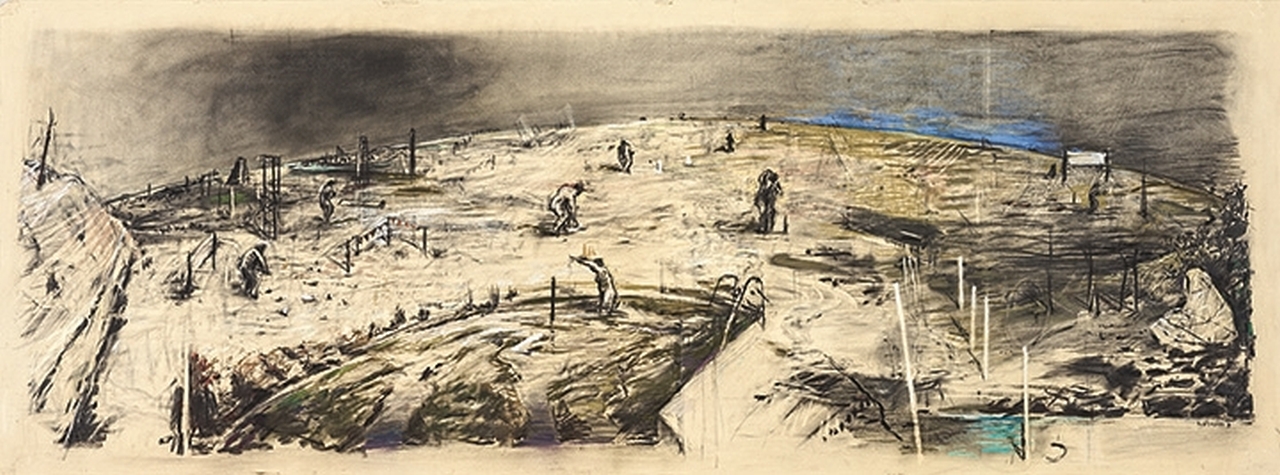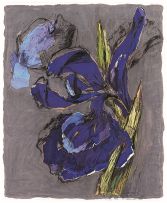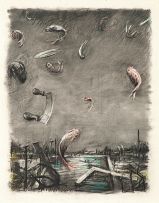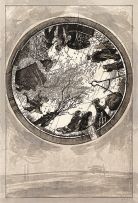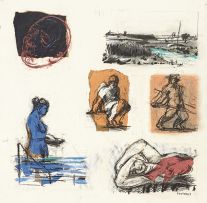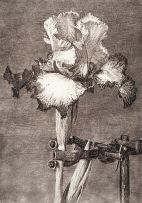Extensive Landscape with Figures and Swimming Pool
William Kentridge
Incl. Buyer's Premium & VAT
About this Item
signed and dated '91
Notes
For William Kentridge, the landscape acquires meaning over time, "through the history of human events and the traces these activities leave imprinted on the ground", as Staci Boris has articulated.1 One of the major themes running through his work is the "hidden history" of the landscape - posing the question of how a landscape is represented and whose stories it ultimately tells, and whether those stories are remembered or told at all.2
Kentridge has written extensively on landscape and memory, drawing parallels between the exploitation of the natural landscape and the plight of South Africa's people under Apartheid. Johannesburg and the Highveld's severe landscapes and dystopian city have been an abiding theme in his work. Gradually it developed from a background detail to become a central theme, both conceptually and physically, from the mid-eighties to the early nineties. He rejects the stylistic over-simplification and idealization of the landscape by his predecessors such as JH Pierneef or JEA Volschenk. His view is that the landscape contains the history of events that unfolded there and, in Kate McCrickard's view, "he finds an abject beauty in the iron pylons, the pipes and culverts that criss-cross South Africa's veld".3
In the quotes below the artist elaborates on his process:
"For about a year I have been drawing landscapes. They started off as incidental details in other drawings. A window behind a couple dancing, an open space behind a portrait. Gradually the landscape took over and flooded interiors. Few of the people in the pictures managed to retain their place in them. The drawings are in charcoal on a rough paper so images which seem solid and dark can be removed with a swipe of a cloth. Traces are left. Even after scrubbing the paper there is evidence of some disturbance. But this is easily overgrown and incorporated into the drawing. A few of the drawings are specific places but most are constructed from elements of the countryside around Johannesburg."4
"I suppose my understanding of the countryside is an essentially urban one. It has to do with visions from the roadside, with landscape that is articulated or given meaning by incidents across it, pieces of civil engineering, the lines of pipes, culverts, fences. This is essentially a naturalistic approach to drawing the landscape. One of the ways I work is to drive predetermined but random distances, say 6.3 or 19.8km, and at that point work with what presents itself. This is largely to get away from the plague of the picturesque (though this is almost impossible). Usually I end up with a catalogue of civil engineering details. It has become clear that the variety of the ephemera of human intervention on the landscape is far greater than anything the land itself has to offer. The varieties of high mast lighting, crash barriers, culverts, the transitions from cutting, to fence, to road, to verge, to fields are as great as any geological shifts (particularly on the highveld...)"5
1 Boris, Staci. (2001) 'The Process of Change: Landscape, Memory, Animation, and Felix in Exile', in Sittenfeld, Michael (ed.) William Kentridge, Chicago: Museum of Contemporary Art. Page 29.
2 Ibid. Page 31.
3 McCrickard, Kate. (2012) William Kentrdige. London: Tate Publishing. Page 20.
4 William Kentridge quoted in Cameron, Dan; Christov-Bakargiev, Carolyn and Coetzee, J.M. (1999) William Kentridge. London and New York: Phaidon Press Limited. Page 108.
5 Ibid. Page 110.
